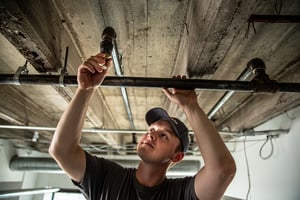
If a fire occurs at your business, the most common and effective means to suppress or extinguish it is a fire sprinkler system. The principle of a typical fire sprinkler is simple; when one or more sprinklers are exposed to heat above a certain limit (typically 155°F.) they open, instantly discharging water directly on the fire.
But there are actually many variations of fire sprinklers and systems, with different maintenance schedules and inspection frequencies. Read on to learn the ins and outs of fire sprinkler systems, and what you need to know about staying compliant with codes.
Types of Systems
While the basic idea of a sprinkler is simple, there are several different types of fire sprinkler systems in use, including:
-
Wet Pipe System: Water is stored under pressure in the pipe and is released immediately through the sprinkler heads that open due to excessive heat.
-
Dry Pipe System: These systems are used in unheated or unoccupied buildings or areas where pipes may freeze and burst. The water is held back at a valve in a heated area. The sprinkler pipe is filled with air or nitrogen. When a sprinkler head opens from the heat of a fire, the air leaks out of the pipe, causing the water to flow through the pipe to the sprinkler heads.
-
Pre-Action System: Pre-action sprinkler systems are a combination of wet and dry pipe systems, typically used in areas at high-risk of water damage. Water is not stored in the pipe until a fire is detected by a separate form of detection (smoke, heat, flame), which releases the water into the pipe. The water is then available at the sprinkler heads if they should operate from the heat of the fire.
-
Deluge System: Deluge sprinkler systems are typically used in areas where rapid fire damage is a major concern, such as chemical plants, aircraft hangers, and flammable liquid storage areas. In these systems, the sprinkler or spray nozzle is always open. They are triggered by a separate form of detection that opens a water release valve which floods the entire area with water through all the sprinklers.
-
Standpipe System: Standpipe systems consist of piping and hose connections installed throughout a building to help firefighters deploy attack hose lines quickly and with adequate water pressure and volume.
-
Foam-Water: These systems, which are normally of a wet pipe or deluge design, utilize a solution of foam concentrate and water to isolate the fuel from the air in fires involving flammable liquids. The foam smothers or blankets the surface of the fuel. The water content of the foam then cools the fuel, and the area of foam covering the fuel prevents reignition of the flammable vapors.
The type of system required will depend on the hazards involved – a hospital may require a different type of system than a factory or warehouse, for example. Our fire and life safety specialists can assist you in determining which system is most appropriate for the anticipated hazards of your business.
Inspections, Maintenance, and Deficiencies
Of course, like all fire and life safety systems, fire sprinklers have specific inspection, testing, and maintenance requirements. These requirements are contained in NFPA 25, Standard for the Inspection, Testing, and Maintenance of Water-Based Fire Protection Systems. All fire sprinkler systems, at a minimum, require:
-
Inspection of specific components with frequencies ranging from daily to 5 years.
-
Complete inspection of all system components performed annually.
-
5-year internal pipe inspections and fire department connection (FDC) hydrostatic (pressure) testing.
Additionally, the sprinkler heads themselves require replacement and/or testing. The timing for this replacement/testing can range anywhere from 5 years to 75 years depending on the sprinkler age, type, and environment.
During fire sprinkler inspection, testing, and maintenance, a trained inspector will examine all components of the system and perform all required test and maintenance items, to ensure your system will operate properly in the event of a fire, and to identify any issues that could impair the system functions.
If deficiencies are identified, a preferred fire inspection team will work with you to provide the necessary components and expertise to resolve those issues and maintain your system in peak operating condition. Common deficiencies for fire sprinkler systems include:
-
Sprinkler heads malfunctioning or not operating caused by the buildup of dust and other foreign materials, such as paint overspray. This problem can be fixed by manually cleaning the heads but over time, if the buildup worsens, it can lead to having to replace the sprinkler head.
-
Missing spare heads or sprinkler head wrench: If you have a wet system with 299 or fewer total sprinkler heads, NFPA requires a minimum of six spare sprinkler heads in case of emergency repairs. It is required that there are at least two of each type of sprinkler head used in the facility. If you have these on hand in case of an emergency, along with a head wrench, it will allow you to have the system returned to service much sooner.
-
Inventory and/or equipment stacked too close to a sprinkler head. NFPA has requirements regarding clearance around sprinkler heads. Ignoring these requirements can cause a delay in sprinkler operation or block the water spray pattern, resulting in a fire becoming much larger or even getting out of control.
-
Internal blockage and corrosion. The 5-year fire sprinkler inspection is crucial. Water in steel pipe creates rust. This rust may accumulate in such a fashion that it could cause a buildup that blocks the pipe. In galvanized pipe, the water introduced into the piping system in conjunction with the air that resides can create rusting and pitting internally. Microbiologically influenced corrosion also causes blockage and pinhole leaks. Additionally, rocks and other debris may enter the system from the water source.
You want to be sure your fire sprinkler system will work when you need it, which is why staying on top of maintenance is critical. Regular inspection, testing, and maintenance ensures that deficiencies are identified and corrected promptly to safeguard your facility in the event of a fire.
Staying on Top of Your System's Inspection Cycle
With so many different components in a fire and life safety system, and with multiple inspection and maintenance needs, it can be confusing to try and keep track of it all.
A preferred fire protection company like CertaSite will make it easy because we handle everything for you. We’ll make sure that the needed maintenance is performed on time. Our expert technicians will help you select the perfect system for your unique needs, and then we’ll keep you compliant through our customized, comprehensive, inspection, testing and maintenance program.




